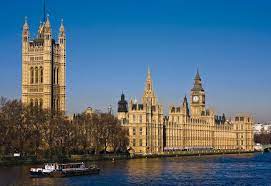
Last week,
in early September, I had an opportunity to attend an event in the House of
Lords, in the Palace of Westminster, in London. The Palace serves as the
British equivalent of our U.S. Capitol building, although it has a considerably
longer history. Originally built in 1016, the Palace was partially rebuilt in
1840 due to a fire that started in the basement, underneath the House of Lords.
The British Parliament and the High Courts of Justice have been based in the
Palace since the 13th century. The impressive building and its inner
courtyards cover eight acres overlooking the Thames River.
London’s most recognizable landmark,
Big Ben, is housed in the Elizabeth Tower of the Palace. Unlike the U.S.
Capitol, Westminster Palace is owned by the Crown. Therefore, King Charles is
the landlord, and the members of Parliament are his tenants. Just as the U.S.
Capitol is the meeting place of the House of Representatives and Senate,
Westminster Palace is home to the British House of Commons and the House of
Lords.
Relative to European history, the
American experiment in self-governance is very young – less than 250 years old.
Even so, most Americans are shockingly ignorant of American history and the
profound lessons that can be learned from our founding fathers. Sad indeed. On
the other hand, British citizens, by and large, have considerable knowledge of,
and admiration for, much of their storied past, especially their Monarchy.
What stuck me while in Westminster
Palace was how many memorials, tributes, paintings, and plaques were placed
throughout the buildings in memory of so many people that few, if any, of us
have ever heard of. It’s almost as if, in death, the unknowns still want to
hang out with the most famous (sometimes infamous) personalities in British
history.
In my view, one of the greatest and
most important British leaders ever was
Winston Churchill. Had it not been for him, England would not have been able to
hold on during the darkest days of World War II. He exemplified courage and
statesmanship. His leadership inspired England – and freedom loving people
around the world. The Palace is not filled with memorials to this important
man. Nevertheless, there is one impressive statue of him (seated) just outside
the entrance to the House of Commons. Additionally, outside of the Palace
grounds, in Parliament Square, stands an imposing statue of Churchill gazing
towards Big Ben.
My Palace visit reminded me of the poem
“Ozymandias,” written by the famous Brit, Percy Shelley, in 1818. He describes
the decaying ruins of a once great statue, with its severed head laying half
buried in sand. The ancient inscription on the cracked base of the ruins states
boldly, “My name is Ozymandias, king of kings, look upon my works, ye mighty,
and despair.” It seems that Ozzie’s glory, like that of all delusional despots,
didn’t last too long.
A British friend once mentioned that,
when you are following a Ford, Chevy, or Toyota, you can easily read the brand
name inscribed on the vehicle. Not so with the renowned British brand, Rolls
Royce. Why? Because the Rolls Royce is inherently unique. Therefore, it doesn’t
need to identify itself. So, too, there are certain unique individuals who
leave their indelible mark on humanity through their inherently unique
achievements. Churchill is one such individual. There are certainly many others
in science, art, music, and philosophy.
Numerous biblical figures, and well-known
Jewish sages and scholars, have stood the test of time. For them statues,
paintings, and plaques are unnecessary. Professor Gerald Schroeder, the
brilliant physicist, often said, “Those who have it don’t have to prove it!”
That’s true in life and in death!
A special friend of mine is an
American psychiatrist (and talmid chacham),
who now resides and practices in Yerushalayim, Yaakov Freedman. He, and I, both
loved, admired, and learned from Rabbi Dr. Abraham J. Twerski, zt”l. Yaakov was present for the funeral
and stone setting for Rabbi Twerski, whose gravesite is in Eretz Hachaim
cemetery in Beit Shemesh. Rabbi Twerski left behind very specific instructions
for his rebbetzin, Gail, and his children regarding his funeral arrangements
and his gravestone inscription. For the funeral, he wanted no hespedim (eulogies). None! He also requested that his remains
be taken to his grave besimcha
(joyously). Therefore, the pallbearers and the mourners sang the music he
composed for (the now famous tune) “Hoshia
es amecha – Deliver and bless your people” (Psalm 28:9) as they accompanied
Rabbi Twerski to his burial.
A few weeks ago, Yaakov sent me a
photo of the gravestone of this incredibly famous and accomplished man. It is
remarkable in its simplicity. The stone states his date of birth, his date of
death, and one short line: “A descendant of the Maharshal.” That’s it! Nothing
else! (The Maharshal was Harav Hagaon Solomon Luria, 1510-1573, the great
halachic and Talmudic commentator.) Rabbi Dr. Twerski’s unique achievements are
his epitaph.
As the days of judgment are upon us,
culminating in Yom Kippur and Yizkor,
many of us, especially as we grow older, are much more appreciative of each and
every blessed day. After my recent Palace visit, I started thinking about
monuments and memorials and wondered how I would like to be remembered.
In a recent parenting workshop I
gave, a very academically focused mother said, “I want my children to do well
in school so that they can get into a top university so that they can have a
good profession. How do you make that happen?”
I’m not sure that she appreciated my
reply. I said, “My wife and I both have advanced degrees. Nevertheless, we
never focused on our kids’ grades. Naturally, we wanted them to do well, but B
grades were okay – and sometimes even a C.”
She looked horrified! I continued, “Our
goal was to raise healthy, happy, well-behaved, and well-adjusted children. Our
focus wasn’t which university, seminary, or yeshiva they would eventually
attend. We simply wanted good kids who would grow up to be Torah observant,
sensitive, respectful, and fulfilled adults.” Clearly, from her body language,
my response wasn’t what she expected or wanted to hear. She was fixated on how
to make a top professional, while I was focused on how to make a good person.
These goals are not mutually exclusive, but making a mensch is first and
foremost. When our children were young, they wanted us to be proud of them,
which we were. Now I hope that they might be proud of us and overlook some of
our shortcomings.
With each passing year, my
understanding and appreciation of Yom Kippur increases. When I was young, I
often wondered what the Al Cheits had
to do with me. As I’ve aged, they, unfortunately, have become much more
relevant. The Al Cheits, the
repetitive Yom Kippur recitation of sins, says everything about menschlichkeit
and nothing about what one might expect – Shabbos, kashrus, and numerous major
commandments. The focus is on our personal conduct. Over one third of the Al Cheits deal with proper speech. These
days, that’s an especially relevant theme! The Al Cheits also remind us that, without proper derech eretz (good manners, sensitivity, and respect), we cannot
really be frum. Being frum requires us to observe the mitzvos bein adam lechaveiro (interpersonal
mitzvos) before we concentrate on the commandments between man and G-d. Simply
put, “Derech eretz kadma l’Torah – Good
manners come before Torah.”
So, what legacy would I most
cherish? Hopefully, something truly lasting and enduring – quite simply, to
have good, G-d fearing, Torah observant descendants who will serve G-d and man
with joy! My late father-in-law, Sam Axelrod, a”h, once said, “My yichus
comes from my children and grandchildren.” So true!
May G-d grant us a year of good
health, peace, and well being. May He extend chesed and rachamim to Klal Yisrael.






